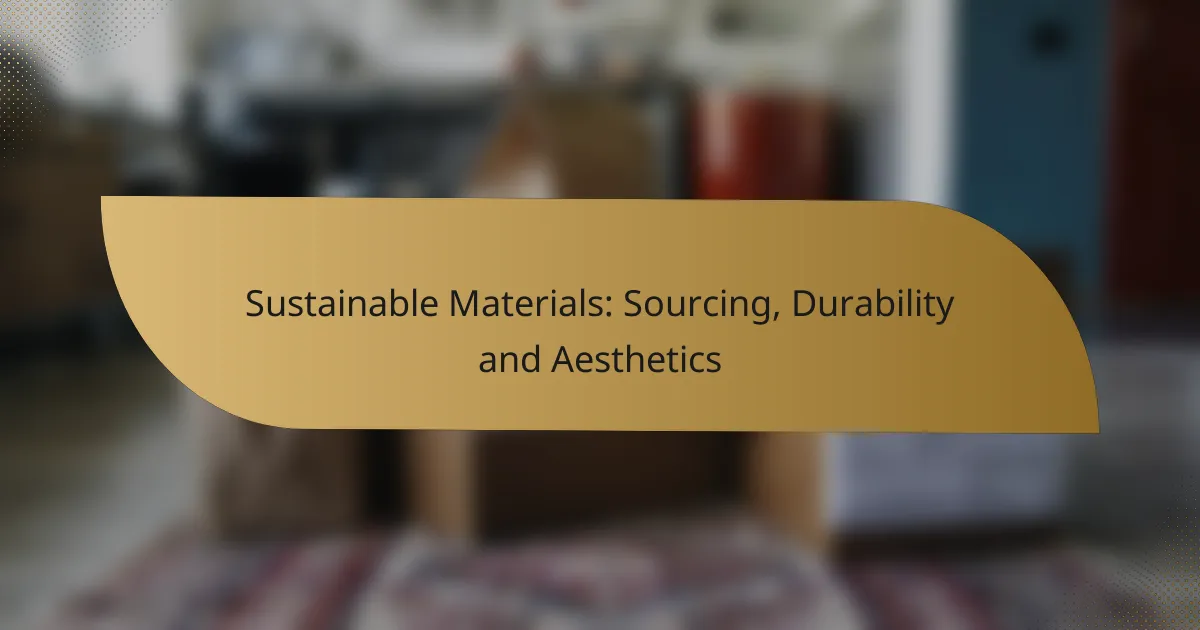Sourcing sustainable materials is essential for e-commerce businesses aiming to prioritize environmental responsibility. By evaluating suppliers and their practices, companies can enhance their brand reputation and foster customer loyalty while benefiting from materials that often match or exceed traditional options in durability.

How to source sustainable materials for e-commerce?
Sourcing sustainable materials for e-commerce involves identifying suppliers and products that prioritize environmental responsibility. This process requires evaluating the sourcing practices, certifications, and overall impact of materials used in your products.
Local sourcing from eco-friendly suppliers
Local sourcing minimizes transportation emissions and supports regional economies. When selecting suppliers, prioritize those who use renewable resources and sustainable practices, such as organic farming or recycled materials.
Look for suppliers within your country or region to reduce shipping distances. This not only lowers your carbon footprint but can also enhance your brand’s appeal to environmentally conscious consumers.
Using certified sustainable material databases
Utilizing certified sustainable material databases can streamline your sourcing process. These databases provide information on materials that meet recognized sustainability standards, such as FSC (Forest Stewardship Council) for wood products or GOTS (Global Organic Textile Standard) for textiles.
By accessing these resources, you can ensure that the materials you choose are verified for their environmental impact. This can also help in communicating your sustainability efforts to customers, enhancing your brand’s credibility.
Collaborating with sustainable brands
Partnering with established sustainable brands can enhance your product offerings and credibility. These collaborations can provide access to innovative materials and practices that align with your sustainability goals.
Consider co-branding opportunities or joint marketing campaigns that highlight your commitment to sustainability. This not only broadens your reach but also fosters a community of like-minded businesses working towards a common goal.

What are the benefits of using sustainable materials?
Using sustainable materials offers numerous advantages, including reduced environmental impact, enhanced brand reputation, and increased customer loyalty. These benefits stem from the responsible sourcing and durability of materials that prioritize ecological balance and social responsibility.
Reduced environmental impact
Sustainable materials are sourced in ways that minimize harm to the environment. This includes using renewable resources, reducing waste, and lowering carbon emissions during production. For instance, materials like bamboo and recycled plastics can significantly decrease the ecological footprint compared to traditional options.
When selecting sustainable materials, consider certifications such as FSC (Forest Stewardship Council) for wood products or GOTS (Global Organic Textile Standard) for textiles. These standards ensure that the materials meet specific environmental and social criteria, further reducing their impact.
Enhanced brand reputation
Brands that utilize sustainable materials often enjoy a stronger reputation among consumers. By committing to eco-friendly practices, companies can differentiate themselves in a crowded market, appealing to environmentally conscious customers. This positive perception can lead to increased visibility and media attention.
To enhance your brand’s reputation, communicate your sustainability efforts clearly through marketing materials and product labels. Transparency about sourcing and production processes can foster trust and credibility with your audience.
Increased customer loyalty
Customers are increasingly drawn to brands that prioritize sustainability, leading to higher loyalty rates. When consumers feel that their purchases contribute to environmental preservation, they are more likely to return for future purchases. This loyalty can translate into repeat business and positive word-of-mouth referrals.
To cultivate customer loyalty, engage with your audience through social media and community initiatives focused on sustainability. Offering loyalty programs or incentives for eco-friendly purchases can further reinforce their commitment to your brand.

How do sustainable materials compare in durability?
Sustainable materials often match or exceed traditional materials in durability, depending on their composition and treatment. Factors such as environmental conditions, maintenance, and intended use play significant roles in their longevity.
Long-lasting natural fibers
Natural fibers like hemp, jute, and organic cotton are known for their durability and resilience. Hemp, for instance, can last for decades when properly cared for, making it an excellent choice for textiles and construction materials.
These fibers are not only strong but also biodegradable, reducing environmental impact at the end of their life cycle. However, they may require specific care to maintain their integrity over time, such as avoiding excessive moisture or direct sunlight.
Recycled materials with high durability
Recycled materials, such as reclaimed wood and recycled plastics, can offer impressive durability. Reclaimed wood, often sourced from old buildings or furniture, is typically more robust due to its age and treatment, making it suitable for high-use applications.
Recycled plastics, on the other hand, are engineered for strength and can withstand various environmental factors. When selecting recycled materials, look for certifications that indicate their durability and performance standards, ensuring they meet your specific needs.

What aesthetic options are available with sustainable materials?
Sustainable materials offer a wide range of aesthetic options, allowing for creative expression while prioritizing environmental responsibility. From natural textures to vibrant colors, these materials can enhance the visual appeal of any project.
Variety of textures and colors
Sustainable materials come in numerous textures and colors, providing flexibility in design. For instance, reclaimed wood can showcase unique grains and finishes, while bamboo offers a smooth, contemporary look. Additionally, organic textiles can be dyed using natural pigments, resulting in a rich palette that is both vibrant and eco-friendly.
When selecting colors, consider the source of the materials. For example, materials like cork and hemp can have earthy tones, while recycled plastics can be available in a broader spectrum. This variety allows designers to create visually striking spaces that align with sustainable principles.
Customizable designs using sustainable practices
Customizable designs are a significant advantage of using sustainable materials. Many eco-friendly options can be tailored to meet specific aesthetic preferences without compromising their environmental benefits. For example, furniture made from sustainably sourced wood can be crafted into various shapes and finishes to suit different styles.
Moreover, incorporating local artisans into the design process can enhance the uniqueness of the project. By using locally sourced sustainable materials, you not only support the community but also create one-of-a-kind pieces that reflect regional aesthetics. Always ensure that customization aligns with sustainable practices to maintain the integrity of the materials used.

What are the costs associated with sustainable materials?
The costs associated with sustainable materials can vary widely based on factors such as sourcing, production methods, and long-term benefits. While the initial investment may be higher than conventional materials, the overall value often increases due to durability and lower maintenance costs.
Initial investment vs. long-term savings
Investing in sustainable materials typically requires a higher upfront cost, which can deter some buyers. However, these materials often provide significant long-term savings through reduced energy consumption, lower maintenance needs, and increased lifespan.
For example, energy-efficient windows may cost more initially but can lead to savings on heating and cooling bills over time. Homeowners might save hundreds of dollars annually, making the initial investment worthwhile.
Price comparisons with conventional materials
When comparing sustainable materials to conventional options, prices can differ significantly. Sustainable wood, for instance, may be priced in the mid to high range per square meter, while traditional lumber is often less expensive.
However, it’s crucial to consider the total cost of ownership. Sustainable materials may offer better performance and durability, which can offset their higher initial costs. For instance, while recycled metal roofing might cost more upfront, it can last decades longer than standard roofing materials, resulting in lower replacement costs.

How to evaluate the sustainability of materials?
To evaluate the sustainability of materials, consider their sourcing, durability, and aesthetic qualities. Key factors include certifications, lifecycle impacts, and the environmental footprint of production processes.
Understanding certifications like FSC and GOTS
Certifications such as the Forest Stewardship Council (FSC) and Global Organic Textile Standard (GOTS) provide assurance that materials meet specific sustainability criteria. FSC certification ensures wood products come from responsibly managed forests, while GOTS certifies organic textiles, ensuring they are made from at least 70% organic fibers and processed without harmful chemicals.
When selecting materials, look for these certifications as indicators of sustainability. They not only reflect ethical sourcing but also adherence to environmental standards, which can enhance the overall appeal of your project.
Assessing lifecycle impacts
Assessing the lifecycle impacts of materials involves examining their environmental effects from extraction to disposal. This includes evaluating energy consumption, greenhouse gas emissions, and waste generation throughout the material’s lifespan.
Consider using tools like Life Cycle Assessment (LCA) to quantify these impacts. For example, materials with a longer lifespan and lower maintenance needs often have a smaller overall environmental footprint. Prioritize materials that are recyclable or biodegradable to minimize waste.

What trends are emerging in sustainable materials?
Emerging trends in sustainable materials focus on reducing environmental impact while enhancing functionality and aesthetics. Key developments include innovations in biodegradable options, increased use of recycled materials, and a growing emphasis on local sourcing to minimize carbon footprints.
Innovations in biodegradable materials
Biodegradable materials are gaining traction as consumers seek eco-friendly alternatives. These materials break down naturally over time, reducing landfill waste and pollution. Innovations include plant-based plastics, mycelium composites, and organic textiles, which offer both functionality and sustainability.
When considering biodegradable options, it’s essential to evaluate their degradation conditions. Some materials require specific environments, such as industrial composting facilities, to break down effectively. For example, polylactic acid (PLA) plastics can decompose in commercial composting settings but may not break down efficiently in home composts.
To choose the right biodegradable material, assess its intended use and disposal method. For packaging, look for options that are certified compostable, while textiles should be evaluated for durability and lifecycle impacts. Avoid materials that claim to be biodegradable without proper certification, as they may not meet environmental standards.
